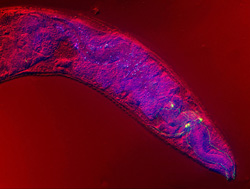Joining the genetic dots
In animals, microRNAs (miRNAs) base pair with messenger RNAs (mRNAs) to target them for cleavage (division) or translational repression. Repressed target mRNAs build up into cytoplasmic structures called P-bodies. At this point, some targets may be degraded while others are stable and can be re-expressed. Little is known about the fate of the repressing miRNAs in either instance. Are they recycled or degraded? Both miRNA under- and over-expression can result in developmental abnormalities and lead to human diseases. In cancer, miRNAs may function as tumour suppressors and oncogenes. This knowledge calls for work aimed at the control of miRNA levels in the cell by advancing understanding about miRNA turnover. Such an achievement would offer insight into the miRNA metabolism circuit and improve our understanding of pathological states linked to miRNA dysregulation. The 'Elucidation of a microRNA turnover machinery in C. elegans' (MIRT) project aimed to identify miRNA turnover machinery or its component(s) and arrive at a biochemical characterisation of miRNA turnover and its workings. Knowing that miRNA homeostasis is further regulated by degradation of mature miRNAs, the EU-funded project partners worked on the hypothesis that an additional layer of regulation of miRNA activity exists. Experiments indicate that substantial regulation of miRNA activity takes place during biogenesis and therefore downstream of transcription. Offering an excellent model organism for genetics and cell biology studies, C. elegans was chosen by team members to biochemically summarise multiple steps of miRNA biogenesis and turnover. Positive results revealed that working with C. elegans does not limit the strength of biochemical approaches. This outcome also opens up new paths for C. elegans research in a number of fields. MIRT's results have many implications for study of human diseases brought on by dysregulation of miRNA expression, although the mechanisms remain largely ill defined. The project findings will contribute significantly to future studies of miRNA regulatory networks, thanks to the knowledge that abnormal miRNA expression levels are in fact linked to various diseases.







